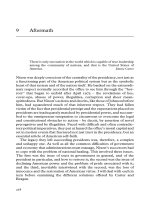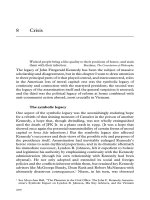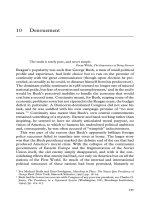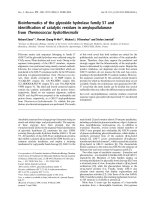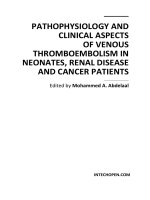Trial and Error: J. Marion Sims and the Birth of Modern Gynecology in the American South docx
Bạn đang xem bản rút gọn của tài liệu. Xem và tải ngay bản đầy đủ của tài liệu tại đây (215.01 KB, 8 trang )
1
1
Trial and Error: J. Marion Sims and the Birth
of Modern Gynecology in the American South
By Urmi Engineer
(Ph.D candidate in History, UC Santa Cruz)
Introduction
Until very recently, many gynecological textbooks and historical accounts have referred
to James “Marion” Sims as the “Father of American Gynecology,” and the “Father of Modern
Gynecology” because of his pioneering research in female reproductive surgery. Examining the
Sims’ life in a world historical perspective, as a social biography, reveals the colonial origins of
the field of gynecology and the degree to which colonial ideologies of race and gender impacted
the development of modern medical institutions and practices throughout the world.
Sims, a South Carolina native, became the world’s leading authority on female
reproductive health after he spent several years in Alabama conducting painful experiments on
enslaved women in his backyard hospital during the 1840s. By the late nineteenth century he
was internationally praised and rewarded for his surgical discoveries; he is attributed with the
invention the Sims Speculum and the Sims Position, and he patented the use of silver sutures (as
opposed to lead, silk or catgut
i
, which typically caused infections). He was the founder of the
nation’s first women’s hospital in New York City, and he traveled to France, Italy, Germany,
Portugal, Spain, and other European venues to demonstrate his surgical techniques and aid in the
establishment of women’s hospitals in those countries. Sims’ influence extended throughout the
United States and Europe, and in many ways he was responsible for articulating gynecology as a
specialized medical discipline in modern medical institutions. Ideas about biological difference
based on race, class, and ethnicity formed the basis of Sims’ experimental methodology, but
these issues were largely ignored among medical elites for most of the twentieth century. Sims’
professional success shows the impact he had on medical institutions on a global level, and his
conceptions of race and gender illustrate how regional ideologies in the antebellum South
impacted the development of the field of gynecology, throughout the world.
While the medical career of Sims is obliquely present in histories of medicine, the
implications of his methodology have not been sufficiently explored among world historians; the
racial and gendered aspects of his medical research not only demonstrate how modern
gynecological procedures developed in the United States; his influence on the global medical
elite shaped the science of gynecology around the world. An analysis of the origins of medical
development in the South provides another locus in the larger discourse of colonial medicine in
the late nineteenth century, especially in terms of race and gender.
Several other pioneer obstetricians and gynecologists were born and raised in the
antebellum South, but I will not have time to discuss them in this paper. I will focus primarily
on Sims because of the global recognition he received and the medical authority that he
possessed from the 1860s through the 1880s. The history of the emergence of gynecology
occurred in the context of the growth of medical institutions and increasing specialization in
scientific disciplines globally, during the 1870s and 80s.
i
tough cord prepared from the intestines of the sheep or goat, or occasionally from those of the hog, horse, mule, pig,
and donkey
2
2
During this period medical practitioners became significantly more competent in treating
patients, especially in the field of surgery. Their success was largely on account of the
development of modern medical technologies, including anesthesia and sanitation guidelines.
Most surgical procedures prior to this period eventually failed because of the high rate of
infections caused by unclean instruments used during the procedure. Further, many doctors
during the Victorian period refused to examine women internally, and especially objected to the
use of instruments. They argued that the use of a speculum or microscope to view female
reproductive organs was a kind of sexual violation. Midwives assisted pregnant women during
childbirth until the mid-nineteenth century, and hospital care was reserved for more complicated
cases.
I should note that during the period between the 1870s and the turn of the century, the
legitimacy of midwives was called into question because they were not trained at professional
medical institutions and could not qualify for a medical license. Although they did not practice
medicine per se, many women worked in hospitals as nurse-practitioners or in administrators.
However during most of Sims’ medical career midwives assisted and attended to pregnant
women during childbirth, and in fact he was more interested in experimenting with surgical
techniques than he was in assisting women during pregnancy or childbirth.
Sims’ professional success and world fame were a result of his surgical discoveries,
including the invention the Sims Speculum and the Sims Position, and the use of silver sutures to
prevent internal infections. These innovations eventually enabled him to repair a vaginal
disorder known as vesico-vaginal fistula.
1
These are small tears inside the vagina, causing
urinary incontinence and pelvic discomfort; if these lesions are left untreated, they can spread to
the bladder, cervix, and uterus.
2
These tears can occur during childbirth, most commonly during
cases of prolonged labor.
Women have been afflicted with vesico-vaginal fistulas for centuries, but only a handful
of doctors in Europe attempted to cure this condition in the nineteenth century.
3
Most were
unsuccessful in their operations because they knew very little about internal female reproductive
organs, and experimental procedures often failed because medical practitioners did not work
under sanitary conditions or use sterile instruments, often making the woman’s condition worse
by causing infection. However, a few physicians in the mid-century documented successful
attempts at removing the fistula, and used instruments that were very similar to Sims’.
Although he was not the first physician to experiment with different treatments or
surgeries, Sims was the first to effectively publicize his methods and instruments. He did not
actually invent the techniques he is famous for, but he organized them systematically into a
package that doctors could adopt throughout the world.
He standardized and patented the duckbilled speculum and silver sutures, and combined
these tools with the position that he ‘discovered,’ which enabled him to view the pelvis while
conducting the surgery. His numerous publications and travels to Europe brought him a great
deal of fame and international recognition.
Sims’ impact on medical development in Europe during this period of colonial expansion
cannot be understated. His patients included monarchs such as the Empress of France,
Scotland’s Duchess of Hamilton, and the Empress of Austria. He served as president of the
American Medical Association in 1876, president of the International Medical Congress in 1877,
and president of the American Gynecological Society in 1880. When he died in 1883 the
medical society of the District of Columbia held a memorial service at the national capital, where
3
3
many physicians expressed their respect and admiration of Sims’ accomplishments. One
announced that,
“Dublin, London, Paris, and Brussels were each in turn the theatre of
his surgical triumphs. He operated in nine different hospitals in
London, and perhaps a greater number in Paris. His successes were
so noted and brilliant that he speedily received decorations from the
governments of France, Italy, Germany, Spain, Portugal, and Spain as
a public benefactor.”
4
Southern Origins
It is crucial to consider Sims’ family history, social status, and his cultural ties to the
American South as the context of his early gynecological experiments and subsequently
successful medical career. Born in 1813, he grew up in the rural backcountry context of
Lancaster County, in the South Carolina piedmont.
Sims was raised in a large yeoman household with eight brothers and sisters, and his
family experienced financial difficulties during his childhood.
5
His father, Jack Sims, owned a
tavern. Sims remembers that his father spent most of his time fox-hunting, cock-fighting, and
playing billiards. His mother, Mahala Mackey, operated the only bed and breakfast in the
county, until she died an early death at the age of forty. Although they were poor and in debt,
the family was able to buy a few domestic slaves.
6
When Sims told his father that he intended to become a doctor, his father famously
discouraged him, saying “there is no science in it (and) there is no honor to be achieved in it.”
7
This was a popular perception of the field; in the South Carolina piedmont in the 1830s, a career
in medicine did not have many social or economic benefits. Most doctors did not have any
formal medical training, and further most practitioners were unsuccessful in their attempts to
treat disease.
Sims began his education during a liminal period in orthodox medical development,
when common therapies which included massive dosages of mercury, calomel, and opium,
combined with the extensive use of bleeding, cupping, and leeching. These ineffective methods
did not evoke confidence among most lay people.
8
Sims decided to pursue a career in medicine for personal and financial reasons. He
wanted to marry Teresa Jones, the daughter of Churchill Jones, who was the only physician in
Lancaster County at the time. Additionally, his father owed money to Churchill’s brother
Bartlett Jones, who worked as a creditor in Lancaster during 1820s and 30s.
9
Sims took a few
classes at a small medical college in Charleston and apprenticed with Churchill Jones while
courting Teresa, and in 1834 he enrolled at Jefferson Medical College in Philadelphia, where he
earned a professional degree within two years.
At this time, medical education was not a prerequisite for practice in the United States.
Until the mid-nineteenth century, most doctors acquired medical knowledge by apprenticing and
attending lectures under the direction of community doctors. The movement from orthodox
medicine to “modern” medicine at the end of the nineteenth century not only reflected
developments in the field of medical science, but also the social and cultural ideologies of the
men who engaged in medical research and clinical practice. A physician’s personal experiences
and moral ideas about science, tradition, and religion shaped their methodology and practical
4
4
concerns. Between 1830 and 1880, their “style of medicine began to make the shift toward what
became accepted as ‘modern’ healing, with its emphasis on biomedical science, institutions, and
specialism.”
10
A large number of professional medical schools formed during this period, and
the number of medical students increased substantially.
Most Southern states began requiring doctors to have a medical license between 1870 and
1890, but state medical societies did not oversee the curriculum and content of medical
education.
11
In the mid-nineteenth century, More than one hundred medical colleges were
established in the United States, and the city of Philadelphia emerged as the center of medical
education in the nation.
12
In an international context, Philadelphia ranked with Edinburgh and
London in its reputation among medical elites.
Before 1800, American medical schools had only produced 221 medical graduates, and
less than one-third of practicing doctors in the country had obtained a degree. However, between
1800 and 1859, over 40,000 physicians graduated from Philadelphia’s medical schools.
13
Between 1846 and 1860, the majority of medical students in the city were from the Southern
states.
However, medical students did not learn about female reproductive health in their classes.
Sims did not acquire his knowledge of female reproductive disorders during the short time he
spent in medical school. As he points out in his autobiography, his professional success was a
result of the experiments that he conducted when he moved to Alabama.
Surgical Experiments
In 1835 Sims moved to Montgomery County, Alabama and began his medical practice.
Slaves and free blacks accounted for more than half the population of the county in 1830, and by
1840 they made up 74% percent of the population.
14
This social situation was common across
the “Black Belt,” which consisted of a large majority of enslaved African Americans and a small
but powerful planter elite.
When he began practicing general medicine Sims only treated free blacks in the area, but
as he gained a good reputation he acquired more wealthy patients, and planters paid him to treat
sick slaves. During this time many enslaved women suffered from pelvic pain and incontinence,
the most common symptoms of vesico-vaginal fistula. Sims initially refused to care for women
who had fistulas, although several planters in the county had requested his help. Since Sims’
medical education did not engage in issues of women’s reproductive health, he was only vaguely
familiar with female reproductive organs.
In fact, Sims had no desire to treat female reproductive disorders; in his autobiography he
admitted that “if there was anything (he) hated, it was investigating the organs of the female
pelvis.”
15
In 1845, Sims had his first experience examining the reproductive organs of a female
patient. He treated an older white woman who injured herself when she was thrown off a pony.
She landed on her pelvis, and complained of severe rectal, abdominal, and back pain. Despite
his disinclination to examine her, he felt obliged to help this woman. He instructed her to lie on
her knees and elbows while he examined her and saw what he described as “what no man had
seen before,” and quickly realized that this position would enable more visibility during pelvic
surgery.
Sims used extremely primitive medical techniques in his first surgical experiments;
between 1845 and 1849 he performed numerous operations on enslaved women under unsanitary
conditions and without anesthesia, although he provided them with opium after their surgery. He
5
5
eventually discovered a way to cure the fistula using an unsterilized, slightly bent spoon, which
he later standardized and patented as the Sims Speculum.
While these experiments allowed Sims to learn great deal about female anatomy and
refine his surgical technique, the trial-and-error process of his research exploited the bodies of
three young slave women: Anarcha, Betsey, and Lucy, in addition to many other women whose
names are absent from the historical record. When Sims first moved to Alabama, most of his
patients were free African-Americans, but during the final years of his experiments, he ended up
practicing (literally) on women who he purchased from planters, because they no longer wanted
to pay for their treatment.
The incidence of vesico-vaginal fistulas, the reproductive disorder that led to Sims to his
breakthrough, among enslaved women in the South was disproportionately high during the
nineteenth century. The disorder is not fatal, and most women continued to engage in manual
labor when afflicted. However, most planters were willing to invest in the health of their slaves.
This concern became more central after 1807, when the British abolished the slave trade in their
colonies. Within the next few decades, Mexico and several territories in Spanish America
abolished the slave trade. As it became more difficult and costly for planters to acquire slaves,
they became more interested in the reproductive health of their slaves. They were more inclined
to pay physicians to treat young women with reproductive disorders, and in turn allow these
women time off from their field work.
Although Sims had previously refused to help women with reproductive disorders, he
was willing to use them as experimental subjects when he saw a lucrative opportunity. He
“subscribed to commonly held theory that blacks had a specific physiological tolerance for pain
(and he) never felt the need to anesthetize his black patients in Montgomery.”
16
Since none of
these women left written records, it is impossible to determine their feelings regarding their
surgical experiences. Although Sims expressed his concern for their health in his autobiography,
his sympathetic remarks obscure the painful experiences of these women.
Sims’ first subject, Anarcha, worked on a nearby plantation with 75 other slaves. She
was only seventeen when she underwent her first surgical procedure, in which Sims failed to
remove the fistula. He operated on her 30 times for almost four years before she was “cured.”
17
His unsuccessful surgeries resulted in serious infections and vaginal swelling, and he wrote that
Lucy almost died during one operation.
18
As these women suffered through numerous
gynecological operations in Sims’ backyard, he denied them privacy by allowing other doctors to
observe as he operated on their most private organs.
This image, from an illustrated History of Medicine published in 1961, depicts Sims and
two medical students examining Lucy, while Anarcha and Betsy watch from behind a curtain.
This artist’s rendering does not show the pain or suffering of these women, and fails to include
any sign of their ailments. Lucy is fully clothed and she has not yet situated herself in Sims’
position; further Anarcha and Betsy are shown standing, looking rather healthy, when in fact
they were confined to a bed for at least two weeks after each operation. During this time Sims
did not give them very much food, and he used opium not only for its narcotic properties, but
also to induce constipation during his patients’ recovery time.
In his own articles and public addresses, Sims did not even acknowledge that his early
patients were African-Americans, or that they were enslaved. By 1850 Sims had mastered the
surgical removal of the fistula, and physicians around the world began specializing in female
reproductive surgery, using the instruments and procedures that he had fashioned. In the
diagrams he used to show the details of his surgical findings, he portrayed the patients as white
6
6
women, deliberately avoiding the racial issues associated with his experiments.
19
Although
several of his colleagues knew of his early operations on enslaved women, most medical
professionals ignored the details of Sims’ first experiments.
His institutional contributions, most notably the establishment of first women’s hospital
in the nation in New York City in 1856, transformed the field of women’s reproductive health
around the world, and formed the basis of modern gynecological science.
In New York, Sims only accepted white women as patients. He operated on these
women privately and anesthetized them before their operations, using sterile instruments. He
found that white women were “unable to withstand the operation without anesthesia, and
throughout his medical career Sims maintained a classbound prescription for the use of
anesthesia with an unspoken premise that those women in the wealthy tier were by far the most
vulnerable to pain.”
20
In New York, he conducted experimental procedures on several poor Irish
immigrant women. One woman, Mary Smith, stayed in the hospital for several years at a time
and underwent about 30 surgical operations, just as Anarcha, Betsey, and Lucy did a decade
earlier. He continued working at the Women’s Hospital until about 1859, as sectional tensions in
the United States escalated, and war was eminent. He was a confederate, and he was publicly
outspoken about his allegiance to the South.
The Civil War and Postwar Success
In fact, in 1861, Sims fled the U.S. and lived in Europe for about seven years, where he
found many medical professionals who were interested in his discoveries, and began to replicate
his surgical methods. He conducted demonstrations of his process in Edinburgh, Dublin,
London, Paris, and several other European venues. During this time his clinical interests
changed, as he took on wealthier patients.
He began investigating therapies for sterility, as he was concerned about the declining
birth rate among the elite. He wrote that he could make about 50,000 dollars a year working in
Europe. But, he returned to New York in 1868. Although there was some dissent towards Sims,
especially among the female administrators, or “Lady Supervisors,” he was able to regain a
viable practice and expand the women’s hospital. His financial situation improved tremendously
during the Reconstruction era, contrary to most Southern elites. He actually estimated that he
had become “the second wealthiest of all American physicians.”
21
Eventually, his racial ideology, Southern background, and Confederate allegiance did not
inhibit his success in the postwar years, especially among the European colonial elite. He was
given several awards and honors from European state elites, including the iron cross from
Germany, the order of the knights of the legion of honor from France, and he was also honored
by the governments of Italy, Spain, and Portugal. He was an honorary member of medical
societies in Edinburgh, Brussels, Berlin, Paris, Dublin, and Belgium.
He is memorialized in several monuments in the U.S., including a statue in Central Park.
The inscription on this plaque on the statehouse grounds in Columbia, South Carolina reads:
Where the love of man is, there is also the love of art
He founded the science of gynecology
was honored in all lands and died with the benediction of mankind
The first surgeon of the ages in ministry to women, treating alike empress and slave.
7
7
Sims’ accomplishments were praised by medical elites and published in medical journals
around the world. His international acclaim and postwar success reveal how medical
professionals preserved their racial and gendered ideologies in the name of modern technological
advancement and social progress. At his memorial service in 1883, one physician remarked,
“I cannot repress the pride I feel that this great and good man was a
native of the South, and that I can stand here to-night and claim that
for that section of this Union, although remote from the great centers
of medical learning and the best opportunities of clinical observation
and experimentation, the proud honor of having given to the
profession the bold and intrepid pioneer in the art of gynecology …
that genius, skill, and perseverance which developed it into a science,
in the person of J. Marion Sims, of South Carolina.”
22
Conclusion
Sims’ professional success reveals the impact he had on medical institutions on a global
level, and the fact that most medical professionals, in the North as well as the South, in Europe
and the U.S., did not criticize his methodology. Since his patients have not left records, their
voices remain absent in the narrative of modern medical development. Although Sims was
eventually able to successfully treat cases of vesico-vaginal fistula, his experimental methods no
doubt resulted in painful and traumatic experiences among his first patients.
The history of the etiology of vesico-vaginal fistulas in a world historical perspective
reveals that the condition can occur under many different circumstances. Even today, most
medical textbooks are elusive about the primary cause of the disorder. During the nineteenth
century, the tears were a common result of invasive examinations, using instruments that were
too sharp or mis-shapen. Sims actually acknowledged this in his publications, noting that some
“authors are disposed to attribute the accident, in many cases, to the awkward use of obstetrical
instruments.”
23
But, ultimately he rejects this notion, and becomes less concerned with the
causes of the fistulas and focuses on how to repair the condition using surgery.
An analysis of the various etiological factors that could cause fistulas reveals the impact
that slavery on reproductive health, especially during the nineteenth century. Enslaved women
continued working while they were pregnant, and it is likely that they had higher incidences of
prolonged labor due to the detrimental effects of heavy labor and physical exhaustion during the
late stages of pregnancy. Additionally, rickets was a common condition during this time. It was
especially frequent among slaves who had serious calcium deficiencies during their childhood,
causing bone defects, including pelvic deformities that often prolonged labor. The vesico-
vaginal fistula is no longer a common disorder among women in the United States and Europe,
but is still widespread in parts of East Africa and South America.
1
Harold Speert, Obstetric and Gynecological Milestones Illustrated, (The Parthenon Publishing Group:
International Publishers in Medicine, Science, and Technology, 1996): 485; see also Seale Harris, M.D.,
Woman’s Surgeon: The Life Story of J. Marion Sims (New York: The Macmillan Company, 1950) and James
8
8
Pratt Marr, Pioneer Surgeons of the Women’s Hospital: The Lives of Sims, Emmet, Peaslee, and Thomas
(Philadelphia: F.A. David Company, 1957).
2
John Chassar Moir, The Vesico-Vaginal Fistula (London: Baillière Tindall and Cox, 1961): 17-19.
3
McGregor.
4
J.M. Toner, M.D., “Biography,” read at the Memorial Meeting of the Medical Society of the District of
Columbia, November 21, 1883, in Sims, Story of My Life: 458.
5
Deborah Kuhn McGregor, Sexual Surgery and the Origins of Gynecology: J. Marion Sims, His Hospital, and
His Patients (New York: Garland Publishing, 1990): 9.
6
ibid 10.
7
Sims, Story of My Life: 114.
8
McGregor: 12.
9
McGregor: 16-17.
10
Steven Stowe, Doctoring the South.
11
Janet Golden and Charles Rosenberg, Pictures of Health: A Photographic History of Health Care in
Philadelphia, 1860-1945 (University of Pennsylvania Press, 1991): 4.
12
O’Hara, An Emerging Profession: 69.
13
ibid.
14
McGregor: 24-25.
15
Sims: 231.
16
Martin S. Pernick, A Calculus of Suffering: Pain, Professionalism, and Anesthesia in Nineteenth-Century
America (Columbia University Press, 1985), cited in McGregor: 47.
17
McGregor 52.
18
ibid 48-49.
19
ibid 65-66.
20
ibid 47; she also cites Martin S. Pernick, A Calculus of Suffering: Pain, Professionalism, and Anesthesia in
Nineteenth-Century America (New York: Columbia University Press, 1985), Virginia Thatcher, History of
Anesthesia (New York: J.P. Lippincott Co., 1953), Harvey Graham, Surgeons All (New York:
Philosophical Library, 1957), and Alfred Hurwitz and George A. Degenshein, Milestones in Modern
Surgery (Hoeber-Hoeber, 1958).
21
Terri Kapsalis, Public Privates: Performing Gynecology from Both Ends of the Speculum. (Duke
University Press, 1997):31, 186; she cites Irwin H. Kaiser, M.D., “Reappraisals of J. Marion Sims,”
American Journal of Obstetrics and Gynecology 132 (1978): 878; “Sims and the other gynecological surgeons
made their money by applying the hospital discoveries [made on slaves and poor white women] in
private practice, where they charged stupendous fees.”
22
Alexander Y.P. Garnett M.D., “Remarks,” read at the Memorial Meeting of the Medica l Society of
the District of Columbia, November 21, 1883, in Sims, Story of My Life: 452.
23
J. Marion Sims, “On the Treatment of Vesico-Vaginal Fistula,” in The American Journal of the Medical
Sciences (Philadelphia, 1852, New Series, Vol. XXIII).
